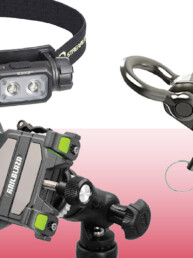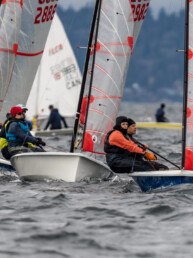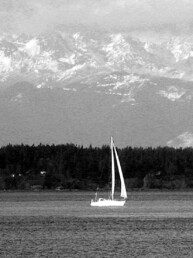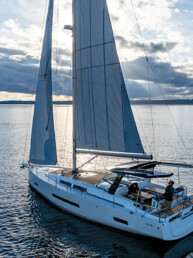In our latest Destinations piece courtesy of Salish Sea Pilot’s Jim Burgoyne, we take a ride through the wonders of Glacier Bay, Alaska.
Lynne was on the phone with our banker, discussing our modest investments, as we motored away from Hoonah and into the mists that hung over the morning stillness of Icy Strait. We were pointing, more or less, toward the entrance to Glacier Bay, distant and murky.
Lynne screamed, a high, single note that might curdle cream. I swung around, to Lynne and to where she was looking, back toward Chichagof Island, to see what had frightened her.
A massive humpback had surfaced 20 meters astern and had startled Lynne. I turned back to her and she was laughing, apologizing to the banker sitting at a desk three time zones away and explaining to him the wonder of whales.

By and by, we neared Glacier Bay and radioed the park office to notify them of our arrival. They gave us instructions on transiting the “whale waters” at the south end of the bay. We were hoping to reach Glacier Bay near the turn and ride the flow to the park headquarters in Bartlett Cove. We timed it well, but the helpful current was barely a knot or so.
I had, of course, misunderstood the instructions for cruising the whale waters and arriving at the park dock we were taken aside by a park ranger who had followed our route on AIS. He explained we had cruised too close to land, endangering whales.
Feeling sloppy, embarrassed and contrite, we attended the required orientation session in the park office with some other boaters, taking things a bit more seriously.

It was June 10 when we arrived in Bartlett Cove, with special permission since our five-day permit to cruise Glacier Bay did not go into effect until June 11. Getting the orientation out of the way would allow us to begin our exploration of the park on the permit’s first day.
Arriving so early in the summer, we were able to obtain a private boating permit quite easily online, though not long after leaving the park we met boaters who had been unable to obtain one. And the park is promising a new permitting process for 2025 so it’s likely our experiences will be irrelevant to you, so we’ll spare you.
We overnighted on anchor off the park dock which by morning was busy with medical personnel. A cruise ship had dropped a hook outside Bartlett Cove and an ailing passenger was transferred to a launch that ferried the patient to the park headquarters and a waiting emergency vehicle. The community of Gustavus and its airport are a short drive away.
We set off near noon, setting off near the turn. We did a better job of keeping to the central channel across the whale waters, keeping at least a nautical mile from shore. We pointed north toward the Marble Islands and soon the bay widened and the snowy mountains gleamed in the sun.
Glacier Bay was created by a recent glacial advance known as the Little Ice Age which reached its maximum extent in the mid-1700s. In a few decades, the rapidly advancing ice had overwhelmed aboriginal communities, forcing many to flee across Icy Strait to find refuge. The town of Hoonah on Chichagof Island was founded by people who fled the glaciers.
By 1750, ice covered the entire valley of what is now Glacier Bay, and the shelf extended miles south of today’s entrance to the bay. The site of today’s park headquarters was buried by the mountainous glacier.

Then the ice reversed course. When Captain George Vancouver visited Glacier Bay some 45 years later, the glaciers had retreated about five miles northward into the bay.
It’s said that 95% of Alaska’s 100,000 glaciers, including those in Glacier Bay, are today retreating, and at a faster and faster rate. To view the few glaciers which still calve into saltwater, boaters must travel 65 miles up into the bay.
We were able to sail as we approached South Marble Island, ghosting on a few knots of wind. The bare rocks of the island were congested with Steller sea lions, the massive creatures — the males can weigh almost 2,000 pounds — loudly barking and squabbling as seabirds swirled in the air above them.
We sailed silently on to North Marble Island where we have read that Puffins are sometimes spotted, but there were none to be seen that day. In fact, not a single bird of any sort. We expect they were all at South Marble Island, dining on scraps left by sea lions.
We anchored that night alone in North Sandy Cove. We had seen only one other boat that day, a 1000-foot-long cruise ship. We had dreaded sharing the bay with ships, but the park has a two-ship limit and ship traffic never seemed excessive. In fact, the behemoths, lined with waving passengers, add something to the ambiance.
Two weeks before, we received a list of Glacier Bay must-sees over dinner at the Juneau Yacht Club. We had been invited to the social evening by club member Sharon Kelly who Lynne had met on Facebook. It was a fun event and we learned much about cruising Southeast Alaska, not only Glacier Bay. So many members we talked to had stories to tell and were so generous with their recommendations. They even gave us a club burgee which we value highly.
The second day of our permit was spent exploring inlets, bays and fjords carved into rock by the long ago flowing ice. We were hoping to see brown bears, creatures of any kind, but no such luck with the possible exception of a chartered powercat near the head of long, lonely and narrow Tidal Inlet.

We were alone when we anchored in Blue Mouse Cove that afternoon, but soon we were surrounded by several other boats in the popular anchorage. Then we were serenaded by the sound of whales expelling air, realizing that two humpbacks were swimming around us, weaving around and under the cruising boats, everyone standing out on deck watching, spellbound, something we will never forget.
The next day was all glaciers and idyllic coves. We sailed past Lamplugh Glacier and into John Hopkins Inlet to view a glacier of the same name, from a distance, since boats are prohibited from crossing an invisible line midway down the inlet in an effort to limit marine erosion of the glacier.
Then it was up Tarr Inlet, past fleets of bergs of all sizes thumping against the hull, to the spectacular Margerie Glacier which rumbles and calves massive chunks of ice.
A French boat was sailing in the shadow of Margerie, the crew looking straight up at the wall of ice. And I was kicking myself for being so cautious, afraid to venture near the glacier, until with a crash a chunk of ice the size of a house fell where the French boat had been just a moment before.

Next door to the Margerie Glacier is the Grand Pacific Glacier which has retreated from the water’s edge, the bright blue ice turned sullen and grey. From here, about a mile inland is the Canadian border, where a tiny finger of British Columbia threatens to lop off Southeast Alaska.
It was growing dark, so we found a fair weather anchorage along the southeast shore of Russell Island at the entrance to Tarr Inlet. Rising winds kept us up most the night and chased us off in the morning, so we returned to the shelter of Blue Mouse Cove to sleep much of the new day away.
The rest of our allowed time in Glacier Bay was spent exploring inlets and bays, seeing as much as we could, not knowing if we will ever return.
And Lynne has this thing for cold water, colder the better, and it is Glacier Bay after all. So we spent a night in the protection of Shag Cove, off Geikie Inlet, where she went in for a dip, her Alaskan pièce de resistance, while I volunteered to remain below, unselfishly mixing the G and T’s.
Note: This article was originally published at SalishSeaPilot.com.






